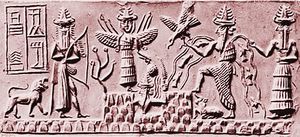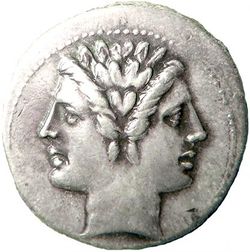What is the history of New Year Resolutions
Every year, many of us make New Year resolutions and, predictably, many of these resolutions are often not kept. While this seems to us as an annual ritual, the history of New Year resolutions is ancient and, just like today, people in the distant past likely struggled with their resolutions. In fact, they created incentives for people to follow through with their resolutions by invoking the gods.
Early History
The oldest recorded New Year resolution dates to about 2000 BC from ancient southern Mesopotamia, in today's southern Iraq, where the New Year, which occurred at about March 20th in their calendar, would be celebrated in the so-called Akitu festival (Figure 1). The festival was about renewal and looking forward to the New Year. People made oaths to their king as part of this ritual; however, there were also more personal resolutions made. If people borrowed goods from their neighbors or others, they pledged to return those goods as part of their resolution. Debts were also to be repaid in the New Year, and people were supposed to make oaths to the gods related to this to help them keep their resolution. Individuals would also likely sacrifice to their gods and would hope by keeping their word to fulfill their obligations, then the gods would return the favor upon them for a successful year.
Rosh Hashanah, which means the head of the year, symbolizes not only the New Year but also the escape of the Hebrews from Egypt. The holiday is celebrated in the early autumn, which was often viewed as the New Year because it was the beginning of the harvest period. It was also considered as a time of reflection and renewal, as is seen today. The Persian cultures would give each other eggs on New Year to wish each other good luck and to reflect on the New Year. Eggs symbolized a new beginning.
Similarly, the Romans, after Julius Caesar reformed the calendar in 45 BC and made January (or the god Janus) the official start of the year, celebrated the New Year by making resolutions. What was different about the Julian Calendar is it marked the first time January 1 was the official start of the year and later became the basis for the Western calendar. The god Janus, who was a god who looked backward and forward and occupied doorways and which reflected the entry of a new beginning symbolically for Romans, symbolized the arrival of the year and expectation for Romans (Figure 2).
The New Year was seen as a time of reflection and promises by the Romans to lead a better life. Sacrifices and offerings to the gods, and Janus in particular, would be made. It was also seen as a time of forgiveness and mistook one perhaps made with others would be reconciled during the Near Year, making it a time of renewal.[1]
When were New Years's Resolutions revived in Western Europe?
In the early Medieval period, celebrating the New Year was not as common, and celebrations were subdued. However, by the late Medieval period and the first Modern period, the clergy did ask their congregation to use the New Year is a time of reflection and to correct mistakes of the past to live a better, less sinful life. Knights would also renew promises by making vows to live a chivalrous life.
The Methodists, in the 18th century under John Wesley, did a special service for New Year, called the Covenant Renewal. This included prayer and hymns, where congregants would renew their commitment to God and each other. However, secular celebrations of New Year did become increasingly common in the 18th century. It was the secular celebrations of New Year that prompted the Methodists and other Protestant churches to commit to New Year services as a way to start the New Year. This tradition continues in many Protestant and non-Protestant denominations today.[2]
Later Developments
The use of the term "resolution" in discussing the New Year may first appear in the magazine Walker’s Hibernian Magazine, where it encourages people to pledge and make resolutions for the New Year. It also gave a list of resolutions that could be taken by different people and professions. In 1813, a Boston newspaper used the phrase "New Year resolution." The newspaper encouraged people to live a less sinful life after the indulgences of the holiday period, and one should focus on living a good, sinless life in the New Year, the newspaper encouraged.
In the Victorian period in Britain, upper-class individuals made it a custom to make more secular New Year resolutions. This custom may have begun or led to the trend of making resolutions to become slimmer or look better, at least in Western traditions. Others made resolutions to have more children or achieve a certain status in society. Arguably, increasingly New Year resolutions in the mid to late 19th century were not just religious but also secular, as people began to make various promises to themselves. In other parts of the world, New Year's resolutions were a mix of secular and religious, often wishing luck and fortune in the New Year.
In many cultures, eating a special type of food on New Year's day is common, which is intended to bring luck in the New Year and help in achieving one's goals in the New Year. Eating sweet foods, symbolizing success, is common. The Dutch, for instance, eat a dough fritter called olie bollen, which symbolizes success and luck in the New Year. While champagne is common in Western countries to toast the New Year, other cultures also have sweet or alcoholic drinks used to wish each other well in the New Year.[3]
Modern History
The tradition of New Year's resolutions continued to be religious for some, particularly Protestant denominations in Western societies, who often would write down their resolutions and periodically check to see they fulfilled them during the year. More recent studies have shown that countries tend to have different types of focus when it comes to making resolutions. In India, it is more common to wish for a prosperous future or better career prospects.
In the United States and Egypt, health was the most common resolution, where both countries struggle with obesity. Australia and Japan focused on love or finding a soulmate. In Russia, it was common for individuals to wish for successful education for their children or others. For many others, having good finances was the most common, in many ways similar to the first New Year resolution known to us from Babylonia, which emphasized getting out of debts. A more recent study using Twitter showed that the top online resolutions were: diet and exercise, reading more, learning something new, saving money, be nicer, get a better job, giving to charity, drinking less, sleeping more, and making new friends.[4]
Summary
New Year's resolutions appear to be very ancient and most of the recorded history associates it with religious behavior or trying to become a better person, invoking God or the gods in helping one achieve their goals. By the 19th century, New Year resolutions that were secular became increasingly common, with familiar ones, such as losing weight, as being one of the goals. Throughout history, it was common for people to struggle to keep their resolutions, with people often sliding back into their old habits. Nevertheless, New Year's resolutions have been remarkably consistent, often focusing on behavior and trying to improve oneself. Reflection but looking forward, as symbolized by Janus, is also true in many cultures and has persisted until today.
References
- Jump up ↑ For more on early New Year celebrations and resolutions in ancient societies, see: Aveni, Anthony F. 2003. The Book of the Year: A Brief History of Our Seasonal Holidays. Oxford ; New York: Oxford University Press.
- Jump up ↑ For more on New Year resolutions in the Medieval and Early Modern period, see: Cole, Jennifer. 2007. Ceremonies of the Seasons: Exploring and Celebrating Nature’s Eternal Cycle. London; New York: Duncan Baird ; Distributed in the USA and Canada by Sterling.
- Jump up ↑ For more on how New Year resolutions developed in the 19th century and the association of resolution with New Year, see: Standage, Tom. 2018. Seriously Curious: 109 Facts and Figures to Turn Your World Upside Down. London: Profile Books Ltd.
- Jump up ↑ For a recent study on using social media to know what resolutions people make, see: Zhu, Dandan, Yusuke Fukazawa, Eleftherios Karapetsas, and Jun Ota. 2012. “Long-Term Goal Discovery in the Twitter Posts through the Word-Pair LDA Model.” In Advances in Natural Language Processing, edited by Hitoshi Isahara and Kyoko Kanzaki, 7614:262–67. Berlin, Heidelberg: Springer Berlin Heidelberg. https://doi.org/10.1007/978-3-642-33983-7_26.

